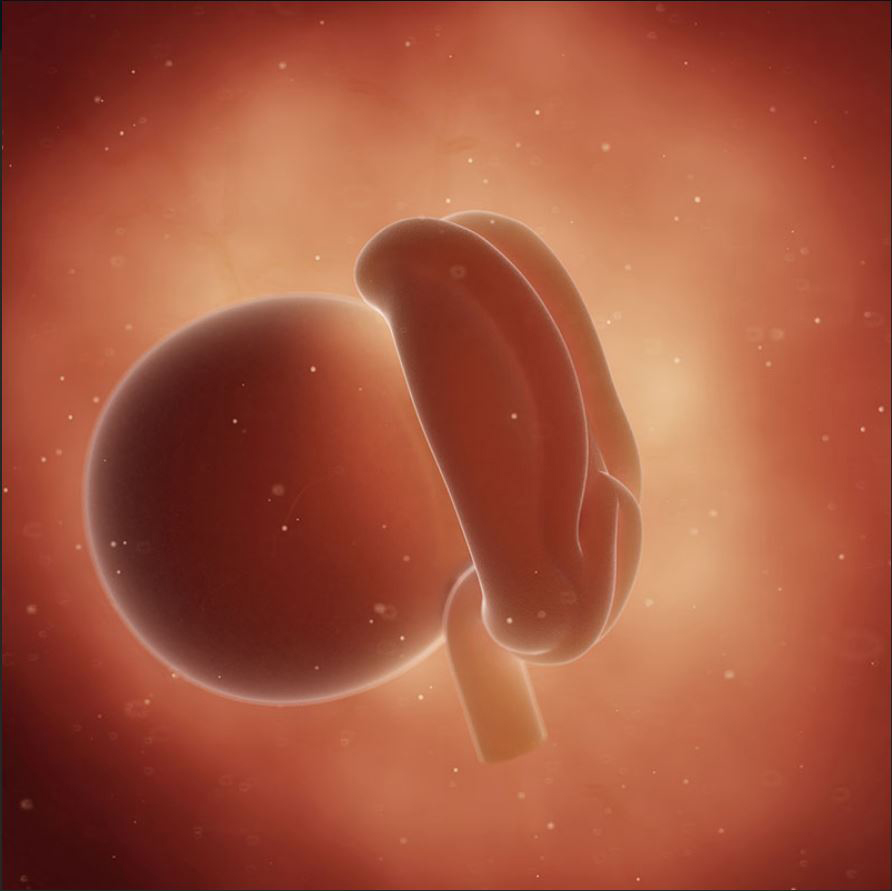
Month 1:
You become pregnant when the successful sperm meets the egg. Thus begins the miracle of life. The nuclei of the male and female cells interact, and new chromosomes are formed, thereby creating a unique genetic code! The first embryonic cells are made of chromatin that turn into chromosomes as they grow: 46 pairs (23 chromosomes from the mother and 23 chromosomes from the father) that determine the baby’s hereditary traits: gender, body type, hair, eye color, skin color, facial features, and some personality traits. The child thus gets part of its genetic makeup from the father, and part from the mother. The possible combinations are infinite. Ten hours after the ovum meets the sperm, the egg is fully formed. Thirty hours later, the cells begin to divide, and the egg splits into two identical cells.
The fertilized ovum stays in the fallopian tube for two or three days, and then descends into the uterus. Cellular division starts slowly at first: there are four cells 48 hours after fertilization, then eight cells 24 hours after that, and then it becomes hard to tell the cells apart. On the fourth day, the fertilized ovum looks a little bit like a blackberry, and is called a morula. It slides down the tube toward the uterus. One day later, as the morula grows larger, it becomes known as a blastocyst. Then, an amazing event occurs during which some cells are designated to become the placenta, and others develop into the embryo, which can already be seen and looks like a protruding bud.
The blastocyst is then slowly pushed toward the uterus and enters it around the fourth or fifth day. This is a crucial phase because if the embryo implants itself on the wall of the fallopian tube instead of in the uterus, it will become an ectopic pregnancy. In order to implant itself in the uterus, the egg must shed its outer capsule so the embryo can latch on to the endometrium, which has prepared itself to receive it.
In terms of the immune system, this miniscule embryo is a foreign body whose protein makeup is totally different than the mother’s. When all goes well, complex systems are put into place to ensure the body does not reject the embryo, and this lasts during the entire pregnancy. If a woman’s body rejects this foreign body, they can have multiple miscarriages or “spontaneous abortions.” Modern medicine can help women who experience multiple miscarriages with a drug that allows the body to accept the embryo rather than reject it.
One mystery remains: how does the egg choose where to implant itself? What factors are at play that enable this implantation? Research is currently moving toward finding ways to assist and improve in vitro fertilization techniques.
Your embryo is now in its eighth day: implantation.
This is the development phase when the embryo forms organs.
Eight days after fertilization, the embryo is burrowed in the lining of the uterus, and begins creating connections that tap into the mother’s circulatory system. Before that it was just floating around the uterine cavity. The egg’s protective membranes permeate the maternal tissue, and go on to form the placenta. By implanting itself like this, it can tap into your blood vessels to get the energy it needs to develop. The baby’s blood circulation is separated from yours by a placental membrane, which has many functions. Soon after the embryo implants itself into the uterine wall, the connections rapidly multiply. The placenta sends hormonal messages to the tiny blood vessels lining the uterine wall. These signals tell the body that a new life is beginning. That is how you’ll supply the embryo all the nutrients and oxygen it needs to grow.
Some placenta cells will produce the hCG hormone (human chorionic gonadotropin) that sends a message to the ovaries and the pituitary gland that you are pregnant. Then, the ovary’s yellow hormone-secreting body (corpus luteum) produces more progesterone, which is pumped into the uterus through the blood system. The progesterone enables the uterine wall to thicken and provide the fetus what it needs.
The blood’s progesterone levels begin to spike 10 days after fertilization. You can feel your breasts becoming tender, you feel like you’ve become pregnant, and you may already be getting bouts of morning sickness.
At the beginning of the fifth week of pregnancy, your embryo only measures a few millimeters, and its body is curled up, soft and transparent. The spinal cord and the brain begin to form.
About a week after implantation, the embryo becomes oval, and then looks like a worm. In order to continue growing, it must connect with your circulatory system through the placenta. A large number of embryos do not manage to make this connection and are then flushed out.
At only about 15 days, we can see that the embryo has already formed nerve cells that will be able to control both the bodily functions and consciousness. Once cell division occurs, each cell’s potential becomes limited. At three weeks, the egg looks like a three-layer disc.
The cells on the top layer become the brain, spinal cord, nerves, skin, hair, and the sweat and sebaceous glands. Other cells will help form the skeleton, muscles, and the blood and lymphatic vessels that will provide white blood cells, as well as the circulatory system and the heart. The cells in the middle layer also supply the ovaries, testicles and kidneys. The inner bottom layer contains cells for the stomach, small intestine, urinary tract system, mucous membranes for the entire body, and the lungs.
This is to show you how extremely fragile the first developmental stages are and that even the smallest alteration to this process can have repercussions on the embryo’s growth and may affect the unborn child. It is important to pay very close attention to your environment and eating habits (it is especially vital to stop drinking alcohol and limit smoking if you cannot consult a doctor to guide you). If the body senses a threat that is too large, it will do its job and expel the embryo. Genetic abnormalities are the most common cause of miscarriages because the ovum or sperm does not contain the right genetic material.
At this point, bleeding may be the first sign of a miscarriage. However, this could often just be bleeding on the projected day of your period, which is normal and no cause for alarm. So before you panic, make sure to see your doctor to check, and keep following strict hygiene practices during your pregnancy. If there is no heavy and dark bleeding, it is probably not a miscarriage, but definitely check with your doctor.
As soon as you show signs of being pregnant, or you get a positive pregnancy test, you should consult your physician to do your first complete physical exam.
At the end of your first month of pregnancy, your period is around 15 days late because ovulation and fertilization usually takes place around the 14th day of your cycle. So you are at six weeks of amenorrhea (six weeks after the beginning of your last period).
Retour à la page mois après mois









